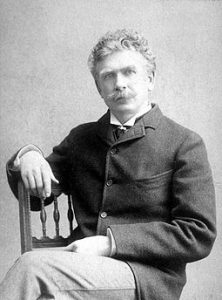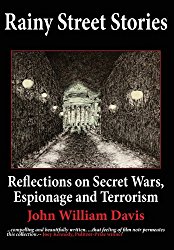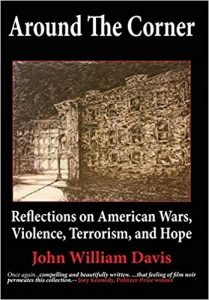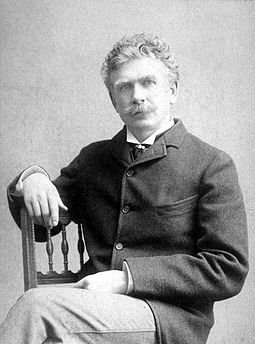Article Written by John Davis

At the dawn of the 20th Century Ambrose Bierce was one of the most famous writers in America. Even today, his “Occurrence at Owl Creek Bridge” is known to readers and media viewers of all ages. He wrote famously for the Hearst newspapers throughout his journalism career which began after his bloody experiences during the Civil War. Indeed, his short stories from that violent combat, in particular, “What I saw at Shiloh” are considered some of the most impressionable and powerful war writings by any American.
.
After the war he traveled throughout the American West, first as a soldier, then as a journalist for numerous papers which carried his tales of our burgeoning, opening frontier. Bierce’s stories captured the essence of life in mining camps, roaring San Francisco, and a host of other places. His articles were known, and craved, by a new reading public. He famously wrote “The Devil’s Dictionary,” which with wit and ingenious twists railed against all manner of verbal frauds. As an investigative journalist he pursued hoaxes, political con men and wrong doers relentlessly. Often, his stories were what today we’d call horror stories, psychological thrillers, and mysteries. It is his lifelong interest in mystery that brings him to our attention.
.
He wrote a series of horrifying short stories toward the end of the nineteenth century on the theme of disappearance. Disappearance without a clue was a theme of dread. It was suggestive of death itself, a virtually taboo question in those Victorian times. In a story with the benign title, “The Difficulty of Crossing a Field”, a Selma, Alabama, antebellum plantation owner, one Williamson, discussed a horse trade with his neighbor, Armour Wren. After a short talk, Williamson departed across a nearby field. And disappeared. Three witnesses saw him, and the sworn testimony was recorded, except of course for the young black servant whose testimony wasn’t considered.
.
In “An Unfinished Race” James Worson wagered he could run forty miles and back. His British neighbors took him up on his drunken bet, and followed at no less than several yards in a cart. At one point, he pitched forward, and was gone. The three credible witnesses could never account for what transpired. In “Charles Ashmore’s Trail,” young Charles Ashmore of Quincy, Illinois, vanished one snowy evening as he went to get water from the family spring outside. After desperate searches, no one found a trace of him, whose tracks simply stopped in the deep snow. Only his mother, then occasionally others in his family heard the faint but clear voice of Charles. He seemed to call, apparently from a distance not clearly defined, irregularly, for some months thereafter. Then nothing.
.
In “Staley Fleming’s Hallucination”, the man Fleming believes he’s ‘a bit loony,’ and tells a doctor. He claims to see a fierce dog in his room at night. After professional preparations at Fleming’s home, the doctor agrees to stay the night. After a shriek, the doctor discovers the complainant dead of an apparent vicious dog bite to the neck. Reference is made to a strange document which avers that as flesh has a spirit, so a spirit can take on flesh, the better to do violence to the living. Bierce records more stories in a similar vein, each more bizarre than the other, but each with a sense of dread that a person can vanish, and no one can account for where, or why.
.
~Article written by John Davis
Read More from John
 John William Davis is a retired US Army counterintelligence officer and linguist. As a linguist, Mr. Davis learned five languages, the better to serve in his counterintelligence jobs during some 14 years overseas. He served in West Germany, Italy, and the Netherlands during the Cold War. There he was active in investigations directed against the Communist espionage services of the Soviet Union and Warsaw Pact. His mission was also to investigate terrorists such as the Red Army Faction in Germany, the Red Brigades in Italy, and the Combatant Communist Cells (in Belgium) among a host of others.
John William Davis is a retired US Army counterintelligence officer and linguist. As a linguist, Mr. Davis learned five languages, the better to serve in his counterintelligence jobs during some 14 years overseas. He served in West Germany, Italy, and the Netherlands during the Cold War. There he was active in investigations directed against the Communist espionage services of the Soviet Union and Warsaw Pact. His mission was also to investigate terrorists such as the Red Army Faction in Germany, the Red Brigades in Italy, and the Combatant Communist Cells (in Belgium) among a host of others.
His work during the Cold War and the bitter aftermath led him to write Rainy Street Stories, ‘Reflections on Secret Wars, Terrorism, and Espionage’ . He wanted to talk about not only the events themselves, but also the moral and human aspects of the secret world as well.

And now recently published in 2018, John continued his writing with Around the Corner: Reflections on American Wars, Violence, Terrorism, and Hope.
Two powerful books worth reading.
Read more about them in the following Six Questions:
Six Questions with John Davis: Author of Rainy Street Stories
Six Questions with John Davis: Author of Around the Corner


That’s a strange way for a man like that to come to an end, whatever that end was. It sounds like it’s tailor made for a followup adventure by another noteworthy.
You open the door 🚪 walk in but noome ever comes out. The mysterious disappearance of noone.
Kinda like you throw your rain coat in the river cuz the rain coat floats.
I keep thinking of Jeff Daniel’s in Bloodwork
Truly a strange story. His collected stories help to understand him…somewhat. His Civil War experiences greatly impacted his life.